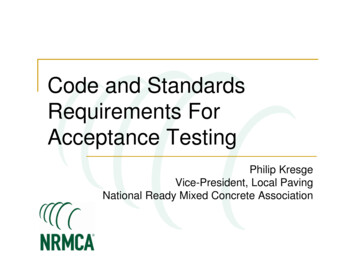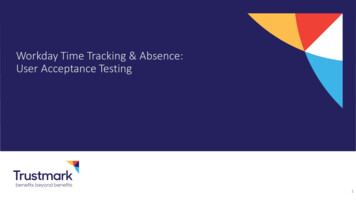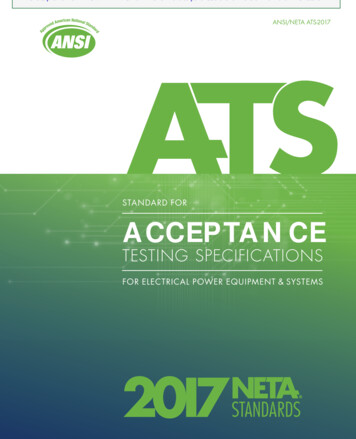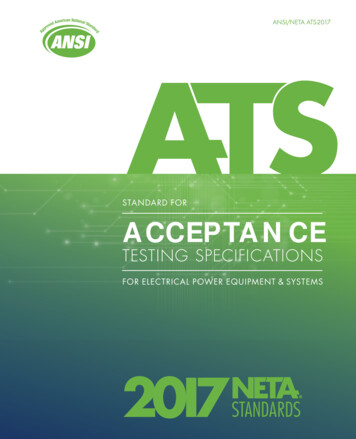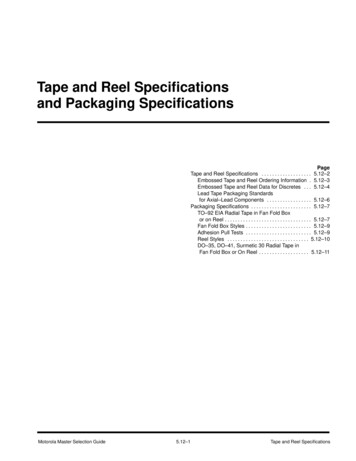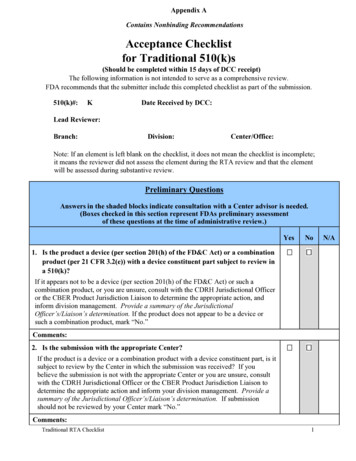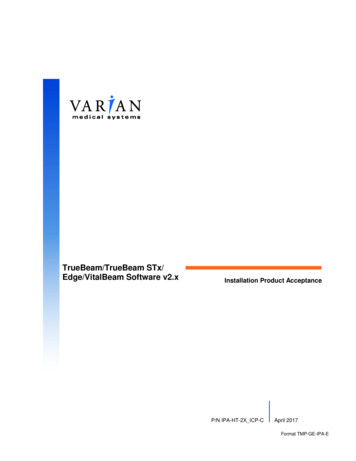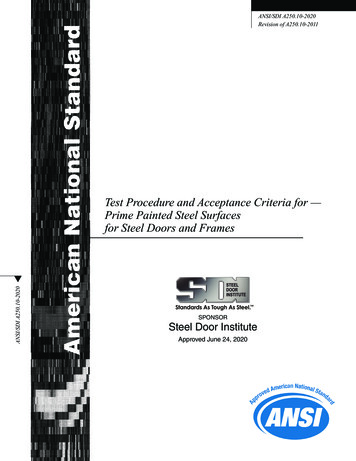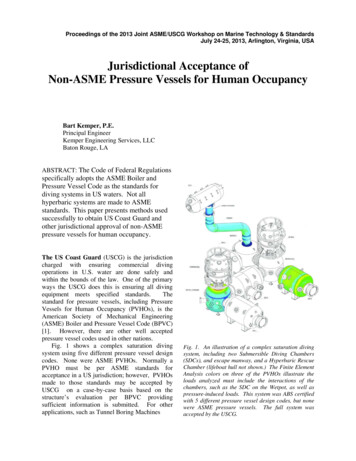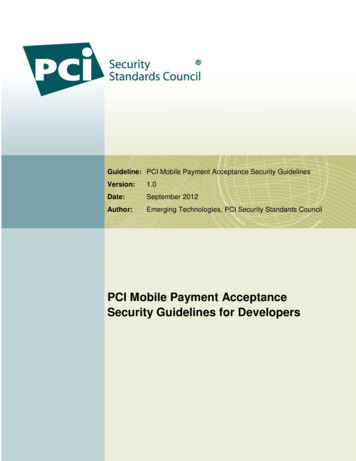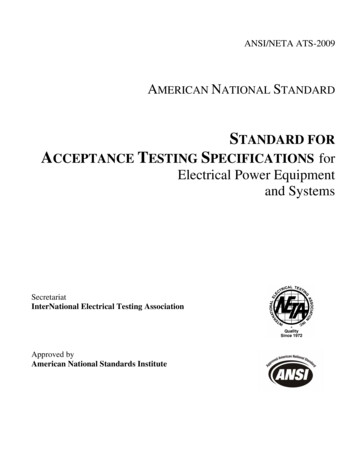
Transcription
ANSI/NETA ATS-2009AMERICAN NATIONAL STANDARDSTANDARD FORACCEPTANCE TESTING SPECIFICATIONS forElectrical Power Equipmentand SystemsSecretariatInterNational Electrical Testing AssociationApproved byAmerican National Standards Institute
– This page intentionally left blank –ANSI/NETA ATS-2009
AmericanNationalStandardApproval of an American National Standard requires verification byANSI that the requirements for due process, consensus, and othercriteria for approval have been met by the standards developer.Consensus is established when, in the judgment of the ANSI Board ofStandards Review, substantial agreement has been reached by directlyand materially affected interests. Substantial agreement means muchmore than a simple majority, but not necessarily unanimity. Consensusrequires that all views and objections be considered, and that a concertedeffort be made toward their resolution.The use of American National Standards is completely voluntary; theirexistence does not in any respect preclude anyone, whether he hasapproved the standards or not, from manufacturing, marketing,purchasing, or using products, processes, or procedures not conformingto the standards.The American National Standards Institute does not develop standardsand will in no circumstances give an interpretation of any AmericanNational Standard in the name of the American National StandardsInstitute. Requests for interpretations should be addressed to thesecretariat or sponsor whose name appears on the title page of thisstandard.Caution Notice: This American National Standard may be revised orwithdrawn at any time. The procedures of the American NationalStandards Institute require that action be taken periodically to reaffirm,revise, or withdraw this standard. Purchasers of American NationalStandards may receive current information on all standards by calling orwriting the American National Standards Institute.Published byInterNational Electrical Testing Association3050 Old Centre Avenue, Suite 102Portage, MI 49024888.300.6382· FAX ne Tanz - Executive DirectorCopyright 2009InterNational Electrical Testing AssociationAll rights reservedPrinted in the United States of AmericaNo part of this publication may be reproduced in any form, in anelectronic retrieval system or otherwise, without the prior writtenpermission of the publisher.ANSI/NETA ATS-2009
Copyright Information andAlteration of Content2009 ANSI/NETA Standard for Acceptance Testing Specifications for Electrical PowerEquipment and Systems (ANSI/NETA ATS-2009) is protected under the copyright laws ofthe United States, and all rights are reserved. Further, the ANSI/NETA ATS-2009 may notbe copied, modified, sold, or used except in accordance with such laws and as follows:Purchasers may reproduce and use all or a portion of the ANSI/NETA ATS-2009 providedANSI/NETA Standard for Acceptance Testing Specifications for Electrical Power Equipmentand Systems are clearly identified in writing as the source of all such uses or reproductions.Section 7 of the ANSI/NETA Standard for Acceptance Testing Specifications for ElectricalPower Equipment and Systems may be reproduced and used on a “cut and paste” basis for theparticular type of equipment to be tested.The following sections of the ANSI/NETA Standard for Acceptance Testing Specifications forElectrical Power Equipment and Systems must be incorporated by reference as part of anysubsection:3.4.5.Qualifications of Testing Organization and Personnel3.1Testing Organization3.2Testing PersonnelDivision of Responsibility4.1The Owner’s Representative4.2The Testing OrganizationGeneral5.1Safety and Precautions5.2Suitability of Test Equipment5.3Test Instrument Calibration5.4Test ReportThe purchaser is required to include the above sections with any section(s) of 7. Copyright 2009InterNational Electrical Testing Association3050 Old Centre Avenue, Suite 102Portage, MI 49024E-mail: neta@netaworld.org Web: www.netaworld.orgANSI/NETA ATS-2009
Standards Review CouncilThese specifications were submitted for public comment and reviewed by the NETA Standards ReviewCouncil.Charles K. Blizard, Sr.Timothy J. CotterDiane W. HagemanRoderic L. HagemanDavid HuffmanRalph PattersonAlan D. PetersonJayne TanzRon WidupBallot Pool MembersOfANSI/NETA Standard for Acceptance Testing Specifications for Electrical PowerEquipment and Systems, 2009Ken BassettTom BishopScott BlizardMichel CastonguayRick EynonDavid GearyDon GenutisPaul HartmanGary HartshornDavid HuffmanStuart JacksonJim JordanScott KinneyAndrew KoblerBenjamin LanzMark LautenschlagerJoe NimsJerry ParnellJaime YbarraMose RamiehRandall SaganPeter SammyRichard SobhrajLarry StovallANSI/NETA ATS-2009Tim ThomasAlan TurpenWally VahlstromChris WerstiukJohn WhiteJP Wolff
NETA Accredited CompaniesThe following in a lisiting of all NETA Accredited Companies as of the date this document wasapproved by ANSI as an American National Standard, February 19, 2009.A&F Electrical Testing, Inc.Kevin ChiltonAdvanced Testing SystemsD. Patrick MacCarthyAmerican Electrical Testing Co.Scott A. BlizardApparatus Testing and EngineeringJames LawlerApplied Engineering ConceptsMichel CastonguayBurlington Electrical Testing Company, Inc.C.E. Testing, Inc.Walter ClearyMark ChapmanDYMAX Holdings, Inc.Gene PhilippEastern High VoltageJoseph WilsonElectric Power Systems, Inc.Steve ReedElectrical and Electronic ControlsMichael HughesElectrical Energy Experts, Inc.William StyerElectrical Engineering Consulting & Testing, P.C.Barry W. TyndallElectrical Equipment Upgrading, Inc.Kevin MillerElectrical Reliability ServicesLee BighamElectrical Testing ServicesFrank PlonkaElectrical Testing, Inc.Steve DoddElemco Testing Co. Inc.Robert J. WhiteESCO Energy ServicesLynn HamrickHampton Tedder Technical ServicesMatt TedderHarford Electrical Testing Co., Inc.Vincent BiondinoHigh Energy Electrical Testing, Inc.James P. RatshinHigh Voltage Maintenance Corp.Tom NationHMT, Inc.John PertgenIndustrial Electric Testing, Inc.Gary BenzenbergIndustrial Electronics GroupButch E. TealInfra-Red Building and Power ServiceThomas McDonaldM&L Power Systems Maintenance, Inc.Darshan AroraMagna Electric CorporationKerry HeidMagna IV Engineering – EdmontonWayne SheridanANSI/NETA ATS-2009
NETA Accredited CompaniesMagna IV Engineering, Ltd. – BCCameron HiteMET Electrical Testing Co., Inc.William McKenzieNationwide Electrical Testing, Inc.Shashikant B. BagleNorth Central Electric, Inc.Robert MessinaNorthern Electrical Testing, Inc.Lyle DettermanOrbis Engineering Field Services, Ltd.Lorne GaraPhasor EngineeringRafael CastroPotomac Testing, Inc.Ken BassettPower & Generation Testing, Inc.Mose RamiehPower Engineering Services, Inc.Miles R. EngelkePower Plus Engineering, Inc.Salvatore MancusoPower Products & Solutions, Inc.Ralph PattersonPower Services, Inc.Gerald BydashPower Systems Testing Co.David HuffmanPower Test, Inc.Richard WalkerPower Testing and Energization, Inc.Chris ZavadlovPowertech Services, Inc.Jean A. BrownPRIT Service, Inc.Roderic HagemanReuter & Hanney, Inc.Michael ReuterREV Engineering, Ltd.Roland DavidsonScott Testing, Inc.Russ SorbelloShermco Industries, Inc.Ron WidupSigma Six Solutions, Inc.John WhiteTaurus Power and Controls, Inc.Rob BulfinchTony Demaria Electric, Inc.Anthony DemariaTrace Electrical Services & Testing, LLCJoseph VastaUtilities Instrumentation Service, Inc.Gary WallsUtility Service CorporationAlan PetersonANSI/NETA ATS-2009
NOTICEIn no event shall the InterNational Electrical Testing Association be liable to anyone for special, collateral,incidental, or consequential damages in connection with or arising out of the use of these materials.This document is subject to periodic review, and users are cautioned to obtain the latest edition. Commentsand suggestions are invited from all users for consideration by the Association in connection with suchreview. Any such suggestions will be fully reviewed by the Association after giving the commenter, uponrequest, a reasonable opportunity to be heard.This document should not be confused with federal, state, or municipal specifications or regulations,insurance requirements, or national safety codes. While the Association recommends reference to or use ofthis document by government agencies and others, use of this document is purely voluntary and not binding.InterNational Electrical Testing Association3050 Old Centre Avenue, Suite 102 Portage, MI 49024Voice: 888.300.6382 Facsimile: 269.488.6383Email: neta@netaworld.org Web: www.netaworld.orgJayne Tanz, CMP - Executive DirectorANSI/NETA ATS-2009
FOREWORD(This Foreword is not part of American National Standard ANSI/NETA ATS-2009)The InterNational Electrical Testing Association (NETA) was formed in 1972 to establish uniform testingprocedures for electrical equipment and apparatus. NETA developed specifications for the acceptance ofnew electrical apparatus prior to energization and for the maintenance of existing apparatus to determine itssuitability to remain in service. The first NETA Acceptance Testing Specifications for Electrical PowerEquipment and Systems was produced in 1972. Upon completion of this project, the NETA TechnicalCommittee began work on a maintenance document, and Maintenance Testing Specifications for ElectricalPower Equipment and Systems was published in 1975.NETA has been an Accredited Standards Developer for the American National Standards Institute since1996. NETA's scope of standards activity is different from that of the IEEE, NECA, NEMA, and UL. Inmatters of testing electrical equipment and systems NETA continues to reference other standardsdevelopers’ documents where applicable. NETA's review and updating of presently published standardstakes into account both national and international standards. NETA’s standards may be used internationallyas well as in the United States. NETA firmly endorses a global standardization. IEC standards as well asAmerican consensus standards are taken into consideration by NETA's Section Panels and reviewingcommittees.The NETA Acceptance Testing Specifications was developed for use by those responsible for assessing thesuitability for initial energization of electrical power equipment and systems and to specify field tests andinspections that ensure these systems and apparatus perform satisfactorily, minimizing downtime andmaximizing life expectancy.Since 1972, several revisions of the Acceptance Testing Specifications have been published; in 1989 theNETA Technical Committee, with approval of the Board of Directors, set a four-year review and revisionschedule. Unless it involves a significant safety or urgent technical issue, each comment and suggestion forchange is held until the appropriate review period. Each edition includes new and completely revisedsections. The document uses the standard numbering system of ANSI and IEEE. Since 1989, revisededitions of the Acceptance Testing Specifications have been published in 1991, 1995, 1999, 2003, and 2007.On February 19, 2009, the American National Standards Institute approved the NETA Acceptance TestingSpecifications for Electrical Power Equipment and Systems as an American National Standard.Suggestions for improvement of this standard are welcome. They should be sent to the InterNationalElectrical Testing Association, 3050 Old Centre Avenue, Suite 102, Portage, MI 49024.ANSI/NETA ATS-2009
PREFACEIt is recognized by the Association that the needs for acceptance testing of commercial, industrial,governmental, and other electrical power systems vary widely. Many criteria are used in determining whatequipment is to be tested and to what extent.To help the user better understand and navigate more efficiently through this document, we offer thefollowing information:Notation of ChangesMaterial included in this edition of the document but not part of the 2007 edition is marked with a blackvertical line in the margin to the left of the insertion of text, deletion of text, or alteration of text.The Document StructureThe document is divided into twelve separate and defined sections:SectionSection 1Section 2Section 3Section 4Section 5Section 6Section 7Section 8Section 9Section 10TablesAppendicesDescriptionGeneral ScopeApplicable ReferencesQualifications of Testing Organization and PersonnelDivision of ResponsibilityGeneralPower System StudiesInspection and Test ProceduresSystem Function TestThermographic SurveyElectromagnetic Field TestingReference TablesVarious Informational DocumentsSection 7 StructureSection 7 is the main body of the document with specific information on what to do relative to theinspection and acceptance testing of electrical power distribution equipment and systems. It is not intendedthat this document list how to test specific pieces of equipment or systems.Expected Test ResultsSection 7 consists of sections specific to each particular type of equipment. Within those sections there are,typically, three main bodies of information:1. Visual and Mechanical Inspection2. Electrical Tests3. Test ValuesANSI/NETA ATS-2009
PREFACE (Continued)Results of Visual and Mechanical InspectionsSome, but not all, visual and mechanical inspections have an associated test value or result. Those itemswith an expected result are referenced under Section 3.1 Test Values – Visual and Mechanical. Forexample, Section 7.1 Switchgear and Switchboard Assemblies, item 7.1.1.7.2 calls for verifying tightness ofconnections using a calibrated torque wrench method. Under the Test Values – Visual and MechanicalSection 7.1.3.1.2, the expected results for that particular task are listed within Section 3.1, with referenceback to the original task description on item 7.1.1.7.2.ANSI/NETA ATS-2009
PREFACE (Continued)Results of Electrical TestsEach electrical test has a corresponding expected result, and the test and the result have identical numbers. Ifthe electrical test is item four, the expected result under the Test
19.02.2009 · NETA’s standards may be used internationally as well as in the United States. NETA firmly endorses a global standardization. IEC standards as well as American consensus standards are taken into consideration by NETA's Section Panels and reviewing committees. The NETA Acceptance Testing Specifications was developed for use by those responsible for assessing the suitability for initial .
